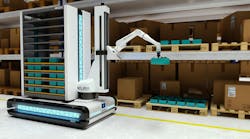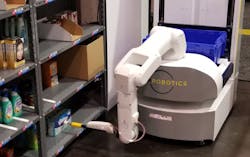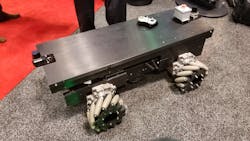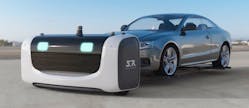Self-driving cars have certainly reaped the rewards from the advances made in sensors, processing power, and artificial intelligence but they aren’t the sole beneficiaries.
One needn’t look any further than to the autonomous collaborative robots (cobots) currently invading the warehouses and stores in which they will work in close quarters with people.
Wandering around this year’s Robobusiness was more interesting since one had to dodge robots in addition to people. This isn’t necessarily new for a robotics show, but some of these robots were a bit bigger and moving more massive objects around without being cordoned off.
Some can move over half a ton of equipment or materials. They may not run as fast as a self-driving car; however, it’s hard to argue with mass and momentum, so safety is as critical for these slower-moving robots as it is for cars.
A number of vendors at the Robobusiness show displayed their wares for warehouses, including Aethon, IAM Robotics, Fetch Robotics, and Vecna Robotics with others providing related support.
Soon it may be typical to see a robot wandering the halls picking up and leaving behind materials for us humans to use.
Aethon’s TUG (Figure 1) is the latest in a line of autonomous robots designed for environments like warehouses. It has more sensors on it than older platforms, which is indicative of the falling price of sensors, improvements in sensor integration, and the use of artificial intelligence to process the additional information.
This allows robots like this to get a better model of the surrounding environment. It means the robots operate more safely since they can better recognize people and objects. It also means they can perform their chores more effectively because they often need to interact with these objects.
Aethon’s TUG series provides a range of capabilities up to versions that can haul around as much as 1,200 pounds. These typically find homes in industrial and manufacturing environments.
Smaller TUGs have been set up in hospitals to deliver medicine, meals, and materials. TUGs move throughout a hospital calling elevators and opening doors via network connections. As with warehouse robots, they operate around the clock doing jobs that allow others to do theirs.
Vecna Robotics has lightweight and heavy-duty robots. Its RL350 robotic lifter can hoist +770 pounds (Figure 2) and can also adjust the payload height with other pieces of material-handling equipment, like conveyor belts.
It can be used in applications such as fulfillment operations or lineside supply. The robot has a top speed of 6.5 feet per second and can run for 8 hours before seeking out a charging station. It's ANSI/ITSDF B56.5 compliant and ISO Class D ready and uses LIDAR and ultrasonic sensors like many of the other robots in its class.
Fetch Robotics has a range of products, from robotic arms for research to its data survey inventory robot. It also offers the Virtual Conveyor (Figure 3), which comes in a number of different sizes to address different weight configurations.
The Freight500 can move up to 1,100 pounds while the Freight1500 handles up to 3,300 pounds. They run up to 9 hours on a single charge and incorporate LIDAR and 3D cameras on the front and rear.
As with most warehouse robots, Fetch Robotics delivers them with its FetchCore Management software.
IAM Robotics includes a robotic arm on its IAM Swift platform (Figure 4) which can run for more than 10 hours picking and placing small objects using its suction grip.
The typical boxes or bottles found on store shelves are fair game. The robot is designed to work with the IAM SwiftLink software.
The IAM Flash 3D scanner is used to teach the system about objects that will be manipulated: recording the barcode, object dimensions, and weight after an object is placed in its scanning area.
The robot can then determine what objects it sees on a shelf or in its basket and moves them accordingly.
Unique Robotic Mobility
Stanley Innovation was showing off some of its hardware at Robobusiness, including a platform that can be used in a warehouse (Figure 5). The trick is that it uses omnidirectional wheels in order to move laterally in any direction from a standing start. This simplifies path planning and allows it to work in tight quarters.
The latest offering from Stanley Robotics was not able to fit on the show floor, though. Its Stan valet parking system (Figure 6) turns any car into a self-driving car—at least to park it.
It rolls under a typical car and then raises itself, thereby lifting the car. Many warehouse robots that lift carts instead of cars use an identical technique—it’s the same idea, but applied to a much larger object.
Inventory Robots
FellowsAI’s NAVii (Figure 7) is designed to operate within a store, providing customers with information while performing inventory scanning. It can map out a store on its own and then track the stock using machine-learning techniques.
NAVii will notify store managers when stock is low, or if there are price discrepancies.
NAVii can also interact with store customers using its display panels. On top of that, store employees can take advantage of this mobile interface to interact with the store’s computer network. As with most autonomous robots, it seeks out a charger when its battery runs low.

















